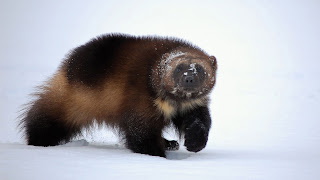At least once a year, I call Fish and Game (and other state Natural Resource departments) with questions about wildlife changes I have noticed. The biologists are always responsive, nice, and well informed.
Below are Q and A from a recent phone call with a Fish and Game biologist:
 |
| Wolverine tracks in the snow |
Q: We saw large bear tracks in the snow on New Year’s Eve, a cold week. No raining into a den. Didn’t the bruin get the memo about hibernating? Why would a bear be out and about that time of year?
A: Bears that are old, starving, or infirm will often leave their den in order to die elsewhere. (That was certainly illuminating to me!)
Q: Since 2007, the first wolf we saw up close was last year, sitting on the frozen lake across from our cabin. This winter, we hear more of them, my dog smells them, and we hear/see fewer coyotes. Insights?
A: Fish and Game had a predator control program in your area of Alaska from 2012 to 2016. We culled the packs to about 41 wolves. Since we stopped, we have recently counted 15 packs of about 125 animals in the region. Yes, as wolf populations increase, they cull coyotes.
Q: We used to see lots of hares and their tracks. Last year and this, very few.
A: We are nearing the end of their 10 year population cycle. You will likely start seeing more hare and lynx tracks (a major predator) in future years.
Q: Last year and this, we have seen more wolverine tracks close to our home. Last winter, one walked right under our cabin, tracking dirt into the snow as he walked down to the frozen lake. This winter we see big tracks and long gaits - bigger and longer than estimated in my “Scats and Tracks” book. A big guy nearby.
A: You live in a zone with a healthy wolverine population. I am not surprised by your observations.
My contact, Chris, was on top of every question I asked. He was great.
 |
| Wolverine (stock photo) |
I forgot to ask him if the death of millions of spruce trees to beetle kill in the past 8 years has impacted animal populations. I would certainly think that as an important component of our eco-system declines, animal populations dependent on spruce would shift. I already see succession plants moving into the newly open areas previously densely shaded by 80 foot spruce trees. We still see spruce grouse and ruffed grouse, but not the darling two families that each year reliably raised babies on our property, marching the little ones to and fro with gentle cooing by the mom. I LOVED those! I saw only one porcupine, years ago, and none since then. We hear fewer owls at night than we used to.
Some years, our land is traversed by several bears (usually black, seldom brown) and moose with calves in June. Other years few. We are down to our last two quarts of bear meat from two years ago. (Saving it for bear tacos). Moose chow down on birch branches, but hide behind healthy, thick spruce boughs, and blend in beautifully. I would think that these enormous ungulates might be easier for predators (wolves and bears) to spot as the spruce thickets thin and die.
Even the population of insects varies (except for
mosquitoes, which are consistently tortuous in June). This rainy summer, we saw very few hornets or
yellow jackets. Nice that the rain had
at least one advantage. When temperatures topped 80 degrees F, the lake never bloomed with a red, waterlogged rainbow of spider mites.
My dog sits inside today, with his paws on the window sill, watching “snow TV.” Yesterday, his hackles rose (for the second time this year), as he smelled or heard wolves behind the trees that line the lake. Observing nature’s changes, from inside and out, entertains me, too.


















